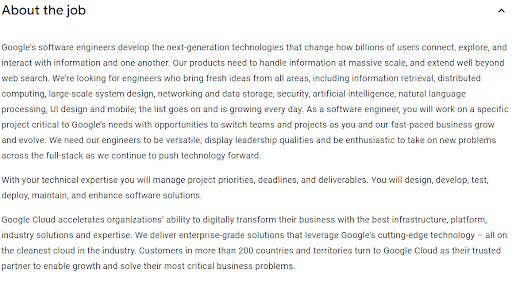“Complex” is one way to describe the last two years. The pandemic and its economic fallout have revealed socio-economic discrepancies and shined a light on issues of diversity, equity, and inclusion (DE&I) in the workplace.
We are also learning more about what it takes to minimize inequalities.
While many organizations have made commitments to diversity, equity, and inclusion, few have made meaningful progress beyond creating DE&I teams and making small investments in training. Case in point: recent data suggests that 50% of LGBTQIA+ employees do not feel comfortable being out to their supervisors.
Clearly, organizations have their jobs cut out for them.
While building an inclusive culture is challenging, it’s not impossible. So, the question is, what should talent and business leaders do to move the needle on inclusivity?
Start with job ads.
Company culture cannot be forced. It develops organically, defined by action, over time. As the team that makes first contact with prospective candidates, talent acquisition plays a crucial role in creating and fostering a more inclusive workforce. According to a survey, 55% of candidates consider job descriptions to be the most important factor when deciding if an employer is a good fit.
So, how do you embed inclusivity in your job ads?
Writing more inclusive job ads begins with understanding language and its impact on jobseekers. The right language not only makes your job ads more inclusive, but also reflects company culture. Here are a few things to keep in mind when writing job posts:
Make sure you\'re prepped for success with our 2024 ultimate guide to diversity hiring.
Is DE&I a Priority for You in 2024?
Avoid gendered language
Research suggests that gendered wording leaves some candidates feeling excluded. Here are some words to avoid when creating inclusive job ads:
- Ambitious
- Competitive
- Confident
- Considerate
- Dominant
- Expert
- Fearless
- Interpersonal
- Superior
- Understanding
Creating job descriptions for technical roles, like software engineers, can be challenging. And these are often the most gender-coded.
In this example of an inclusive job ad by Google, the candidate is referred to in terms of the position. Instead of using “he/she,” the company has subtly used inclusive language by using terms as “software engineer,” and “you.”

Using certain software can help you scan and eliminate words that may potentially impact your application rates and diversity hiring efforts.
Be conscious of ageism and experience bias
Terms like “digital native” – meaning, people born in the internet age – can make more experienced candidates feel excluded. Similarly, listing a requirement for years of experience may be intimidating for some applicants.
Instead of requiring experience, job ads should focus on the key attributes required to succeed in the role: problem-solving skills, a growth mindset, collaboration, etc.

Address racial bias
Terms like “native English speaker” are likely to introduce bias against candidates who are proficient but non-native speakers. Similarly, terms like blacklist, whitelist, cakewalk, and master/slave can promote bias and discourage candidates from underrepresented communities from applying to your jobs.
Here’s a list that Twitter recently released that features changes to their language for coding terms.
Make language universally accessible
Unconscious bias towards people with disabilities can easily seep through language. This holds for both people with physical disabilities as well as neurodiverse candidates.
For instance, Lowe’s uses language inclusive to people with disabilities – instead of saying “Must be able to stand for an entire shift,” they say “Physical ability to perform tasks that may require prolonged standing, sitting, and other activities necessary to perform job duties.”

Lead with the Benefits
Outlining inclusive benefits is a sure-fire way to make your job ads more appealing to candidates from all backgrounds. Paid parental leave, a sensory responsive environment for autistic employees, or insurance coverage for domestic partners can speak to your organization’s values and culture, while creating a welcoming opportunity for all.
Ultimately, creating more inclusive job ads is a team effort – right from business unit leaders, to the hiring managers, and recruiters, everyone must pitch in to make hiring more inclusive. By solving for job ads, organizations can begin using their language style guide across internal and external communications to begin threading together a more inclusive culture.
Let’s talk about how Joveo’s programmatic platform can help you scale hiring efforts. And follow us on Twitter and LinkedIn, where we’re always working to help you get the most out of your recruitment advertising.















